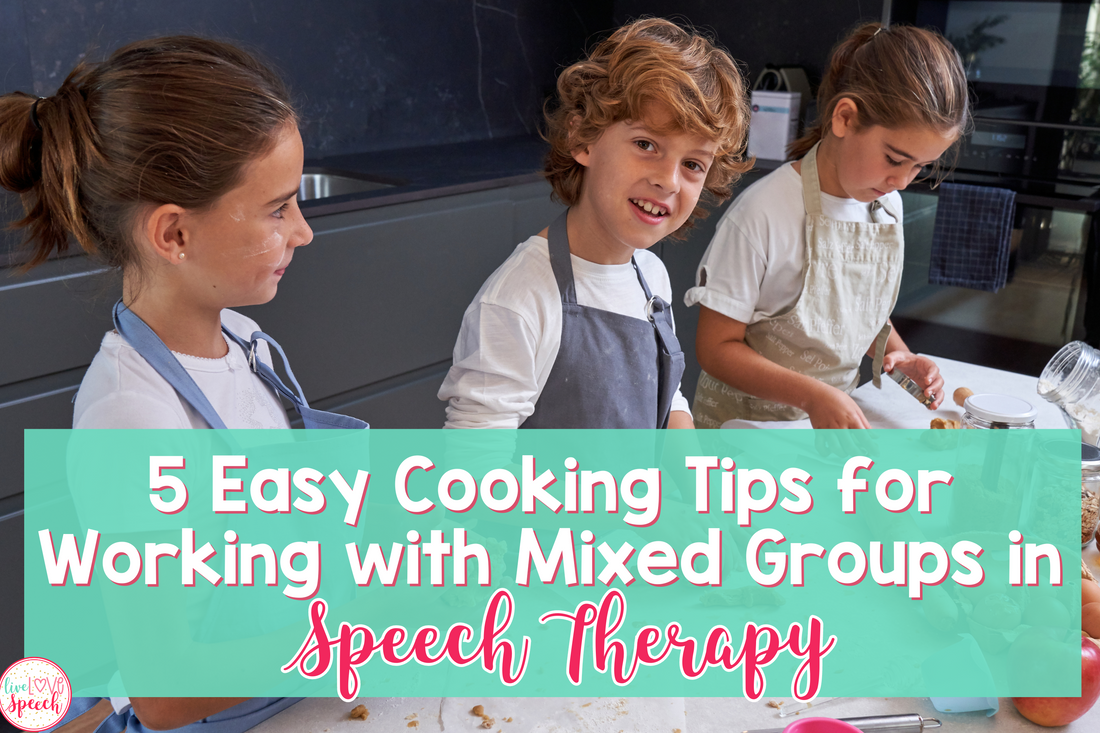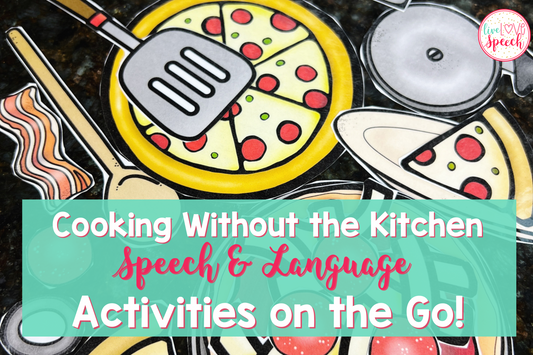
Navigating the busy schedule of a school-based Speech-Language Pathologist (SLP) can be chaotic, am I right? Raise your hand if you run mixed groups! Sometimes mixed groups are inevitable. They can be tricky and overwhelming because of diverse needs of your students, each with unique speech goals and communication styles. However, that's where I come in, giving you tips on how to efficiently manage these groups and guess how I do it? Through COOKING of course! In this blog post I’ll share with you some "Easy Cooking Tips for Working with Mixed Groups in Speech Therapy!"
WHAT ARE MIXED GROUPS?
Mixed groups in speech therapy refer to sessions where individuals with different communication needs & goals are grouped together. For example, one student could be working on articulation (/s/ blends) while another student in the same group could be working on expanding utterances. This type of "mixed group" allows SLPs to address multiple goals and different skills tailored to each individual within a single session. It's a flexible approach that not only promotes efficiency but also creates an inclusive and collaborative learning environment. This way, every student gets a personalized therapeutic experience, fostering growth and progress across various communication domains.
HOW TO MANAGE MIX GROUPS

1. Differentiated Tasks:
Differentiation in speech therapy involves tailoring sessions to meet the unique communication needs and goals of each student/child. It is important to assign tasks that cater specifically to each student's specific goal. For articulation students, the focus may be on words or ingredients that contain their target sounds. Create a practical and engaging context for their practice. Similarly, for language students, emphasizing tasks that promote vocabulary, sentence formation, or social communication ensures a comprehensive and targeted learning experience.
Incorporating visual cues or supports, such as visual recipe cards, serves as an effective strategy to enhance understanding and independent execution of instructions. This visual aid not only benefits articulation students by providing a concrete reference for targeted sounds but also aids language students in grasping and applying new vocabulary, sentence structures, and social communication skills. This integration of differentiation strategies ensures that each student receives tailored support, fostering a more inclusive and effective speech therapy session!
2. Communication-Friendly Environment:
Create a supportive and communicative atmosphere during cooking sessions. Encourage students to talk and interact with one another. You can start with icebreakers where students share fun facts or discuss favorite recipes. Facilitate discussions on cooking techniques, cultural aspects, or personal experiences with food. These approaches foster a supportive and communicative atmosphere, enhancing the overall learning experience.
Promote effective communication behaviors by modeling to your students' essential skills such as taking turns, asking insightful cooking-related questions, and offering constructive feedback. Model active listening as you engage in discussions about cooking techniques and different flavors that might pop-up while cooking, encouraging students to voice their ideas openly. Emphasize the importance of clear communication in the kitchen, creating an environment where everyone's contributions are valued.
3.Targeted Vocabulary:
Choose recipes and activities that introduce and reinforce vocabulary relevant to both articulation and language goals. For example, select recipes that include ingredients with target sounds and offer opportunities to use descriptive words.
For instance, if the target sound is "S," opt for recipes featuring ingredients like "sizzling sausage" or "sautéed spinach." This not only provides opportunities for practicing the target sound but also allows students to use descriptive words such as "spicy," "savory," or "succulent" when discussing flavors. Similarly, for language goals, choose recipes that involve sequential steps, like "layering lasagna" or "rolling sushi," encouraging the use of transitional phrases and enhancing narrative skills.
4. Structured Feedback:

After each cooking activity, provide structured feedback to both articulation and language students. For articulation students, focus on their pronunciation and encourage them to self-monitor. For instance, "Great job on pronouncing the 'th' sound in 'broth' accurately." Encourage self-monitoring by asking questions like, "How did you feel about your 'r' sounds during the activity?" This fosters reflection and self-awareness.
For language students, offer feedback on sentence structure, word choice, and social communication skills. Such as, "I like your description on 'juicy tomatoes,' this made me visualize the details to your explanation." Address word choice by saying, "maybe next time instead of 'good,' you could say 'flavorful'." Additionally, highlight successful social communication skills, such as effective collaboration and clear expression of ideas.
Encourage peers to provide feedback as well, promoting peer-to-peer support and social interaction. It's all about giving each other those friendly pointers to make our cooking and chatting even more awesome. So that we are turning our kitchen into a space where we're all cooking up success together!
5. Collaborative Projects:
Incorporate collaborative projects where students work together on a cooking-related task. For example, they can create a menu, plan a meal, or write a cooking-themed story. This encourages teamwork, problem-solving, and language development for all students.
Assign roles that cater to each student's strengths and goals. For instance, an articulation student can focus on pronouncing menu items correctly. Such as mastering the 's' sound in "spaghetti" or nailing the 'th" in thick tomato toast. While a language student can work on writing descriptions. For example: creating a description for "crunchy carrot sticks"-they make a fun snap, snap sound when you take a bite!

VISUAL RESOURCE!
When incorporating visuals into your mixed groups, consider trying my Visual Recipe Cards! These cards feature 48 kid-friendly recipes and come neatly packaged in a box. The recipes are divided into four categories: Snack Attack, Eat Your Fruits and Vegetables, Sweet Tooth, and Real Meals. What sets these cards apart is the inclusion of step-by-step visual directions, ensuring that each recipe is presented in 5 steps or less. Additionally, the Visual Recipe Cards feature diverse and inclusive characters, fostering a sense of representation. Beyond just cooking, these cards serve as a valuable tool that supports communication and language skills in a fun and engaging way. For more information on my Visual Recipe Cards click here!
Now, go ahead and incorporate these cooking-inspired speech therapy tips into your sessions and see your student's/kids thrive! Foster a fun and engaging learning experience for everyone involved. Happy cooking and communicating!
Save and share with your bestie!




